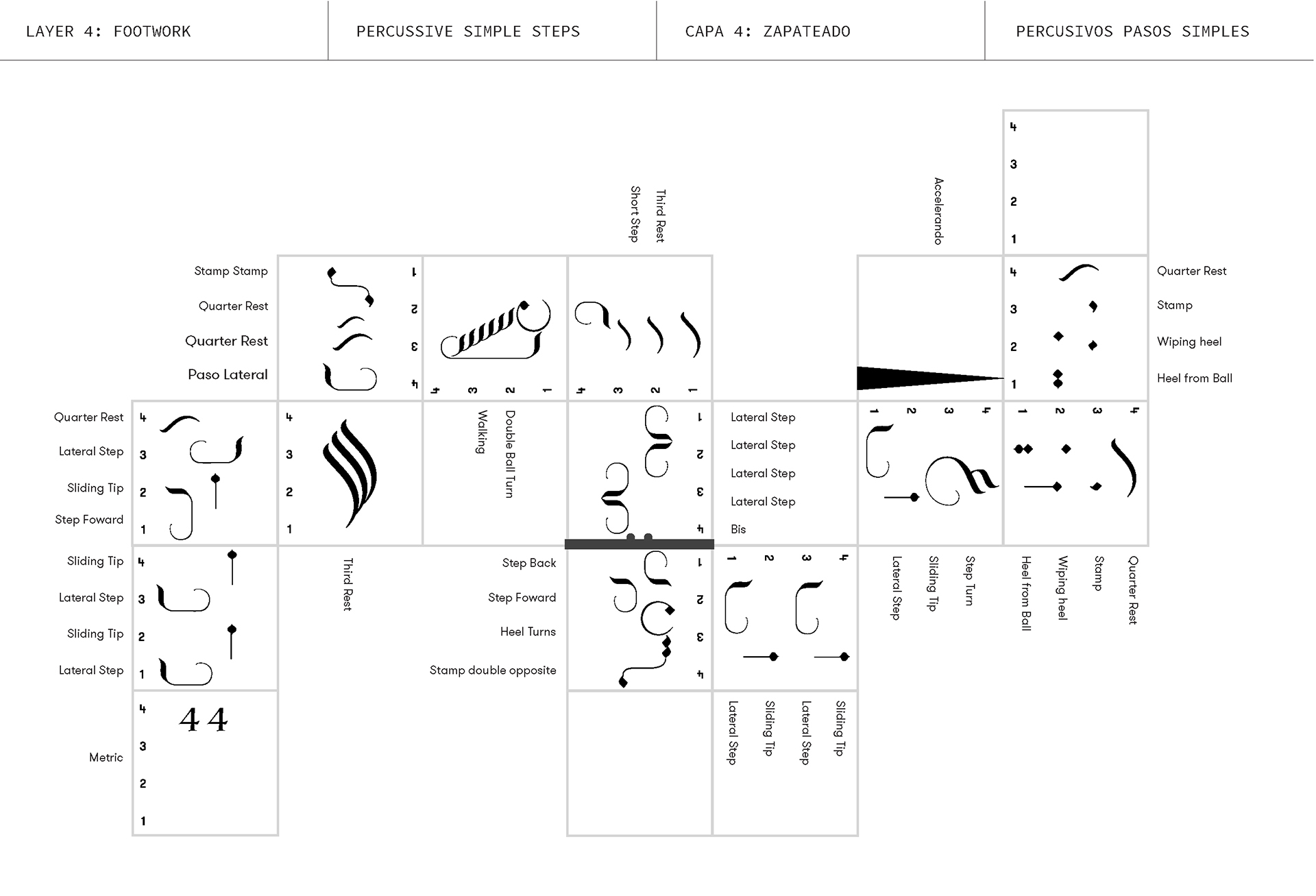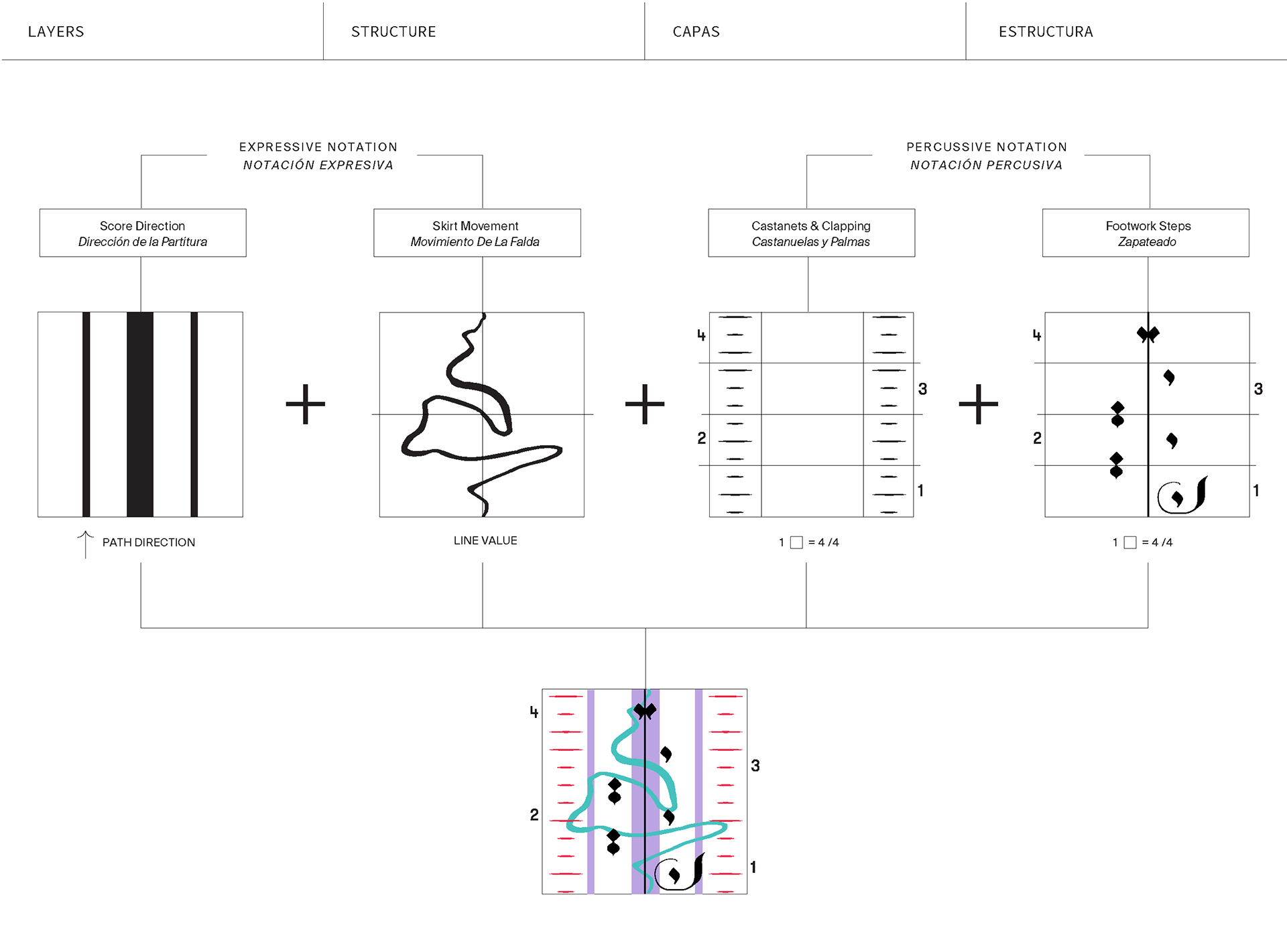EN / ES
RESEARCH
︎︎︎ RIZOMA PHASE I
FLAMENCO NOTATION EXPLORATIONS
︎︎︎ RIZOMA PHASE II
FLAMENCO NOTATION PROPOSAL
︎︎︎ RIZOMA PHASE III
MACHINE LEARNING EXPERIMENTS
︎︎︎ RIZOMA PHASE IV
INTERACTIVE INSTALLATIONS
︎︎︎ RIZOMA PHASE V
BOOK PROCESS
RIZOMA II >
TEST 6. Flamenco Notation Proposal
RIZOMA II >
TEST 6. Propuesta de Notación para el Flamenco
Rizoma Flamenco Notation, is a system to write flamenco dances, considering the percussive steps as footwork (zapateado), castanets, clapping (palmas) and expressive movements as skirt movements and direction of the dancer.
—The system consist in four Layers that work as fonts (Layer 1, 2, 3, 4). This layers create a variety of ornamental composites by superimposing and also the meaning of the choreography and the dance steps.
—Each Layer from Rizoma font contains several symbols/Illustrations, each has a specific place in a square and they all align perfectly centered.
—I separated the four layers in Percussive/Rhythmic and Expressive
/Interpretative.
Rizoma Flamenco Notation, es un sistema para escribir bailes flamencos, considerando los pasos de percusión como zapateado, castañuelas, palmas (palmas) y movimientos expresivos como movimientos de falda y dirección del bailaor.
—El sistema consta de cuatro capas que funcionan como fuentes (Capa 1, 2, 3, 4). Estas capas crean una variedad de compuestos ornamentales superponiendo y también el significado de la coreografía y los pasos de baile.
—Cada capa de la fuente Rizoma contiene varios símbolos / ilustraciones, cada uno tiene un lugar específico en un cuadrado y todos se alinean perfectamente centrados.
—Separaron las cuatro capas en percusivo / rítmico y expresivo / interpretativo.
EXPRESSIVE / INTERPRETATIVE
a. Layer 1: Score (Direction)
Is the path or direction of the choreography (or dancer) and it could be read vertical or horizontal becoming a truly root.
This one has 30 symbols that when combined together they create the direction of the choreography.
The score is placed in the center of the square, and is divided by a line. The line in the center also divides right foot and left foot.
In all my representations this layer has the color Violet.
EXPRESIVO / INTERPRETATIVO
a. Capa 1: Puntuación (dirección)
Es el recorrido o dirección de la coreografía (o bailarina) y se podría leer en vertical u horizontal convirtiéndose en una verdadera raíz.
Este tiene 30 símbolos que cuando se combinan crean la dirección de la coreografía.
La puntuación se coloca en el centro del cuadrado y se divide por una línea. La línea del centro también divide el pie derecho y el pie izquierdo.
En todas mis representaciones esta capa tiene el color Violeta.

b. Layer 2: Skirt (Movement in space)
Is the interpretation of the skirt movement in the space, what it draws in space. The skirt is an extension of the body, which creates a sense of tension between the center and the edge of the movement sphere, a quality known as peripheral spatial tension. A flamenco skirt should be pulled away from dancer’s center, so that its relationship to the dances is always dynamic.
(Kinesphere) The skirt works as a pattern that aligns on the center, it could be linked on the extremes and edge of the square.
This layer is expressive, but it also has intentionality.
The line representing the movement, changes weight and becomes thinner or thicker as a way to indicate the Speed and Intensity the dancer should perform if wearing a skirt or making hand movements. It goes from Piano (very thin) to Fortissimo (thickest part), Crescendo (going from thin to thick) and Decrescendo (going from thick to thin).
This layer also means the position of the dancer on space. Like a Compass (north. south, left and right), placing the dancer on the center. Its up to the dancer if he/she/they wants to interpret this about the skirt direction or the body direction.
This layer is the most organic one, and the forms have infinite ways to create very complex patterns.
In all my representations this layer has the color Green.
b. Capa 2: Falda (Movimiento en el espacio)
Es la interpretación del movimiento de la falda en el espacio, lo que dibuja en el espacio. La falda es una extensión del cuerpo, lo que crea una sensación de tensión entre el centro y el borde de la esfera de movimiento, una cualidad conocida como tensión espacial periférica. Una falda de flamenco debe alejarse del centro del bailaor, para que su relación con los bailes sea siempre dinámica.
(Kinesphere) La falda funciona como un patrón que se alinea en el centro, podría enlazarse en los extremos y el borde del cuadrado.
Esta capa es expresiva, pero también tiene intencionalidad.
La línea que representa el movimiento cambia de peso y se vuelve más delgada o más gruesa como una forma de indicar la Velocidad e Intensidad que el bailarín debe realizar si lleva falda o hace movimientos con las manos. Va de Piano (muy fino) a Fortissimo (parte más gruesa), Crescendo (pasando de fino a grueso) y Decrescendo (pasando de grueso a fino).
Esta capa también significa la posición del bailarín en el espacio. Como una brújula (norte, sur, izquierda y derecha), colocando al bailarín en el centro. Depende del bailarín si quiere interpretar esto sobre la dirección de la falda o la dirección del cuerpo.
Esta capa es la más orgánica y las formas tienen infinitas formas de crear patrones muy complejos. En todas mis representaciones esta capa tiene el color Verde.


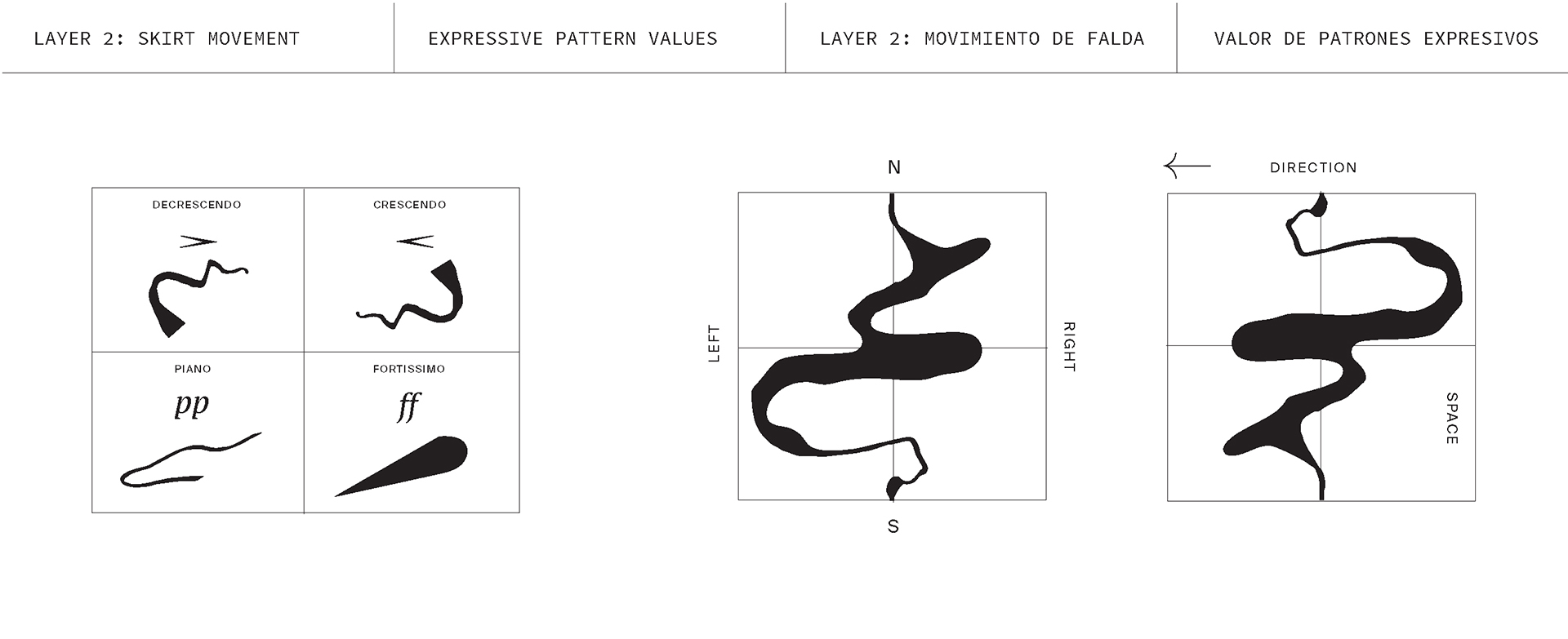
PERCUSSIVE NOTATION
c. Layer 3: Castanets and Clapping
Both are located in the opposite edge of the square.
Right hand for the right side of the square and left hand for the left side of the square.
The castanets work as percussive rhythm, following also the conventional way to write castanets RA RIA PITA mixed with percussive notes.
The clapping is easier to understand, and goes with the rhythm of the metric. It shows graphically the accents bigger (in red) following this logic: 1 2 1 2 3 4 5 6 7 8 9 10
In all my representations this layer has the color Red.
NOTACIÓN DE PERCUSIÓN
c. Capa 3: Castañuelas y Palmas
Ambos están ubicados en el borde opuesto del cuadrado.
Mano derecha para el lado derecho del cuadrado y mano izquierda para el lado izquierdo del cuadrado.
Las castañuelas funcionan como ritmo de percusión, siguiendo también la forma convencional de escribir las castañuelas RA RIA PITA mezcladas con notas de percusión.
Las palmas es más fácil de entender y va con el ritmo de la métrica. Muestra gráficamente los acentos más grandes (en rojo) siguiendo esta lógica: 1 2 1 2 3 4 5 6 7 8 9 10
En todas mis representaciones esta capa tiene el color Rojo.

d. Layer 4: Footwork (steps)
The zapateado flamenco is the most important one.
There are 4 main steps and 4 secondary steps. These steps are the principles in flamenco footwork, depending how the foot stamp the floor:
The first one is Heel (Tacon), which is striking the floor with the heel: second one is Ball (Planta) Striking the ball of the foot on the floor, Third one is Tip (punta) striking the floor with the tip and fourth one is Stamp, stamping with the heel and the ball simultaneously with one foot.
This simple notes, are equivalent to Crotchet notes (one note, value 1/4, one beat).
In all my representations this layer has the color Black or White.
d. Capa 4: Zapateado
El zapateado flamenco es el más importante.
Hay 4 pasos principales y 4 pasos secundarios. Estos pasos son los principios del juego de pies flamenco, dependiendo de cómo el pie pise el suelo:
El primero es Heel (Tacón), que golpea el piso con el talón: el segundo es Ball (Planta) que golpea el piso con la bola del pie, el tercero es Tip (punta) golpeando el piso con la punta y el cuarto uno es Stamp, estampando con el talón y la pelota simultáneamente con un pie.
Estas notas simples, son equivalentes a notas Crotchet (una nota, valor 1/4, un tiempo). En todas mis representaciones esta capa tiene el color Negro o Blanco.

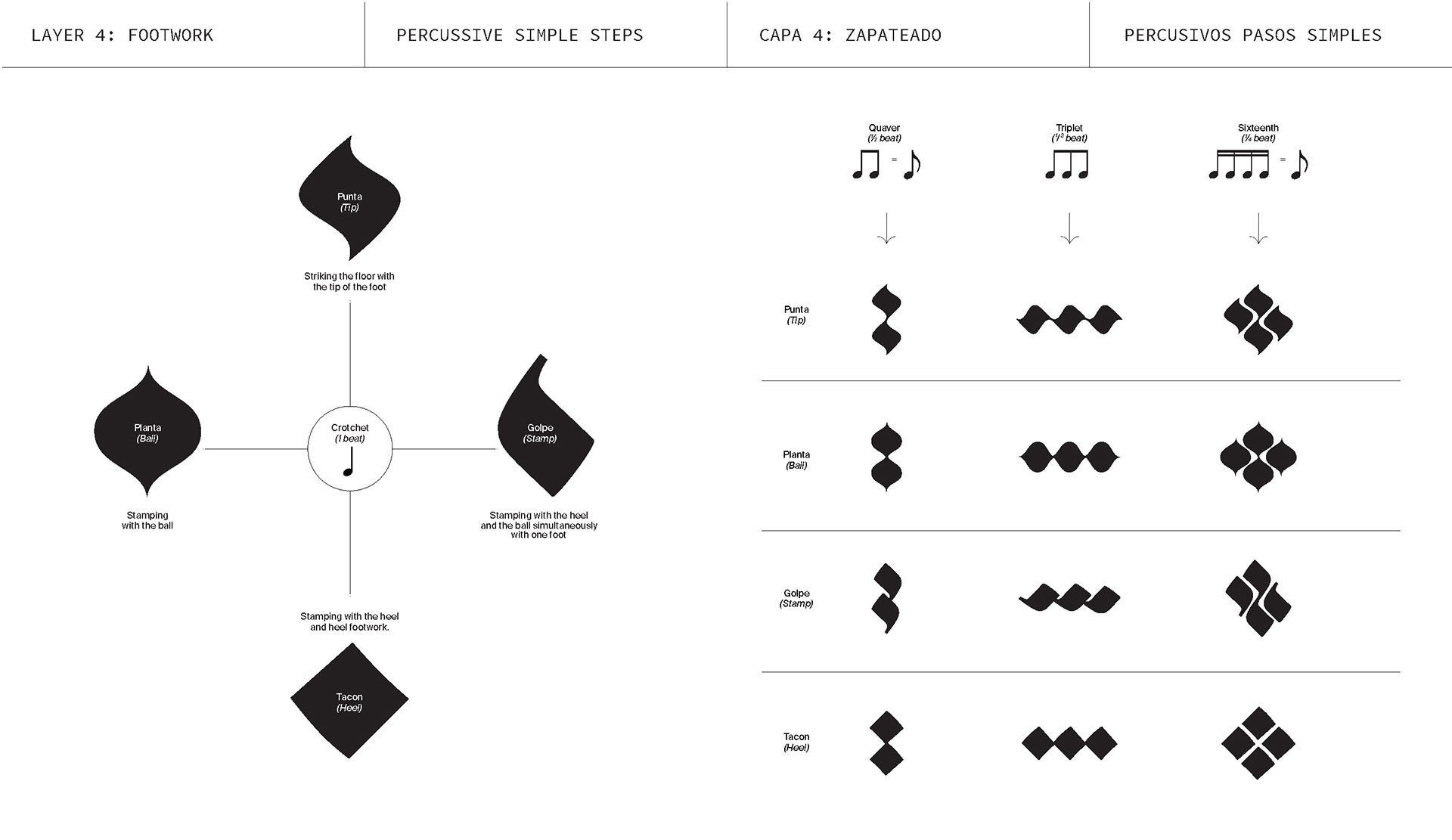
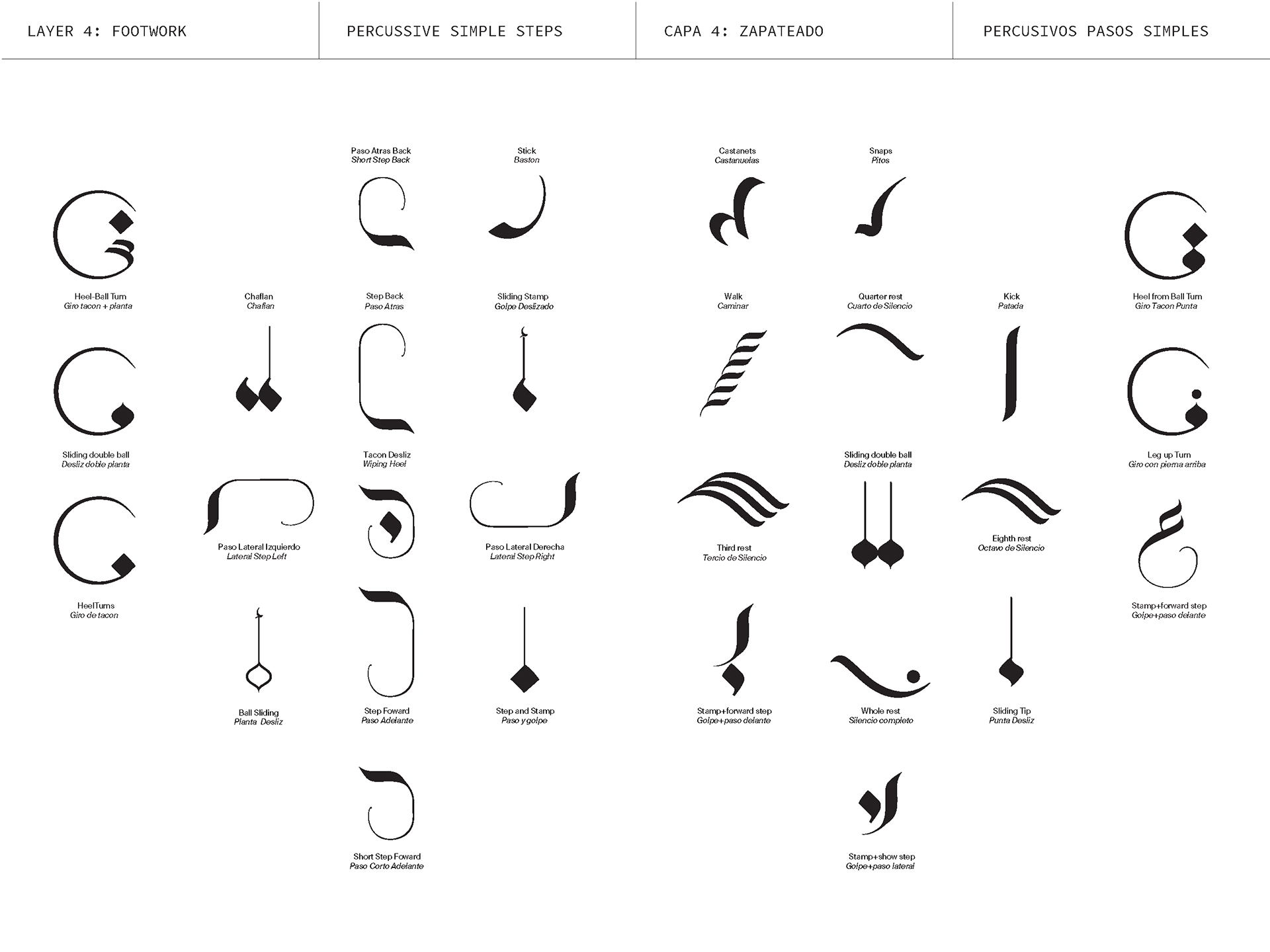
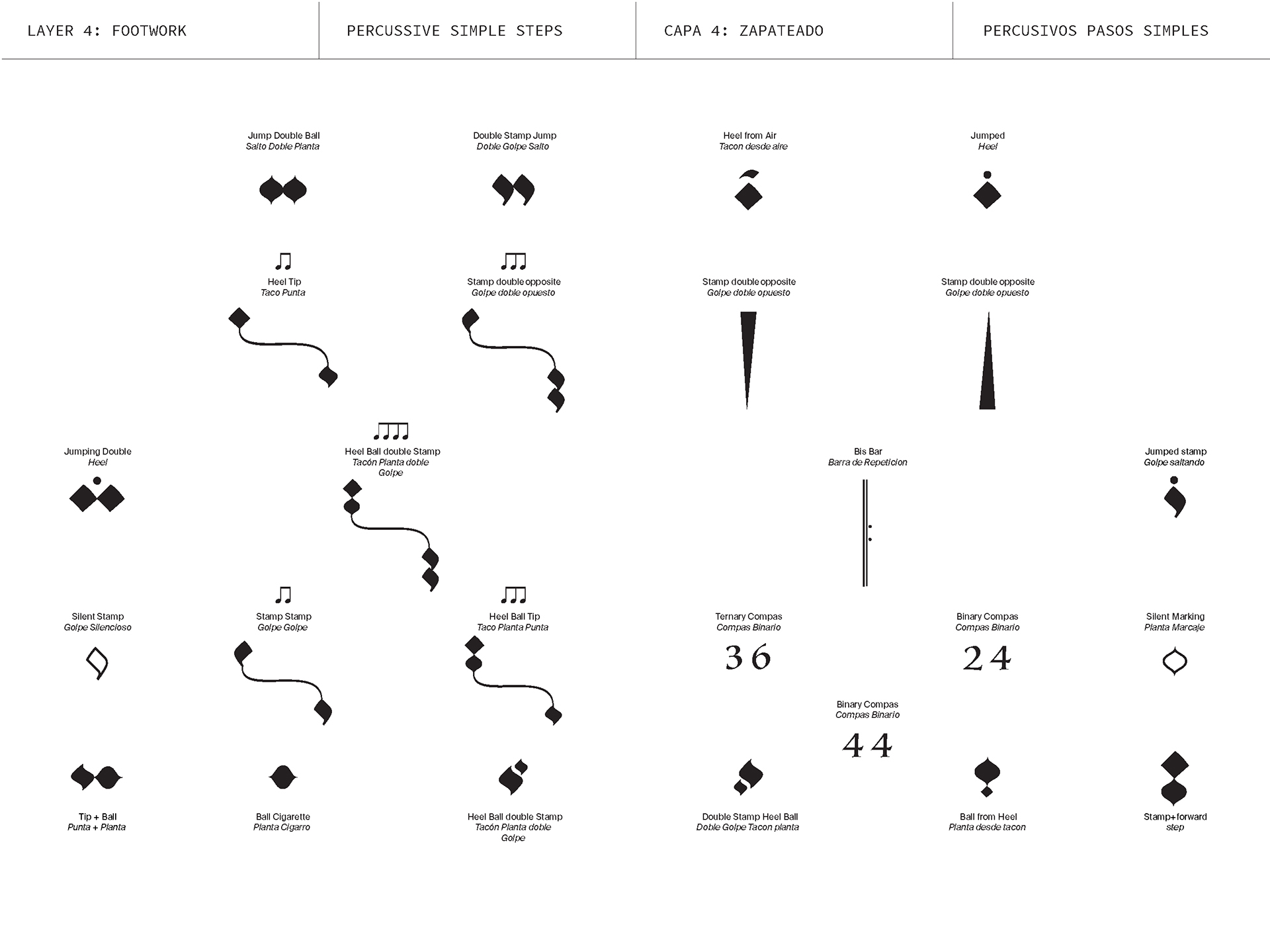
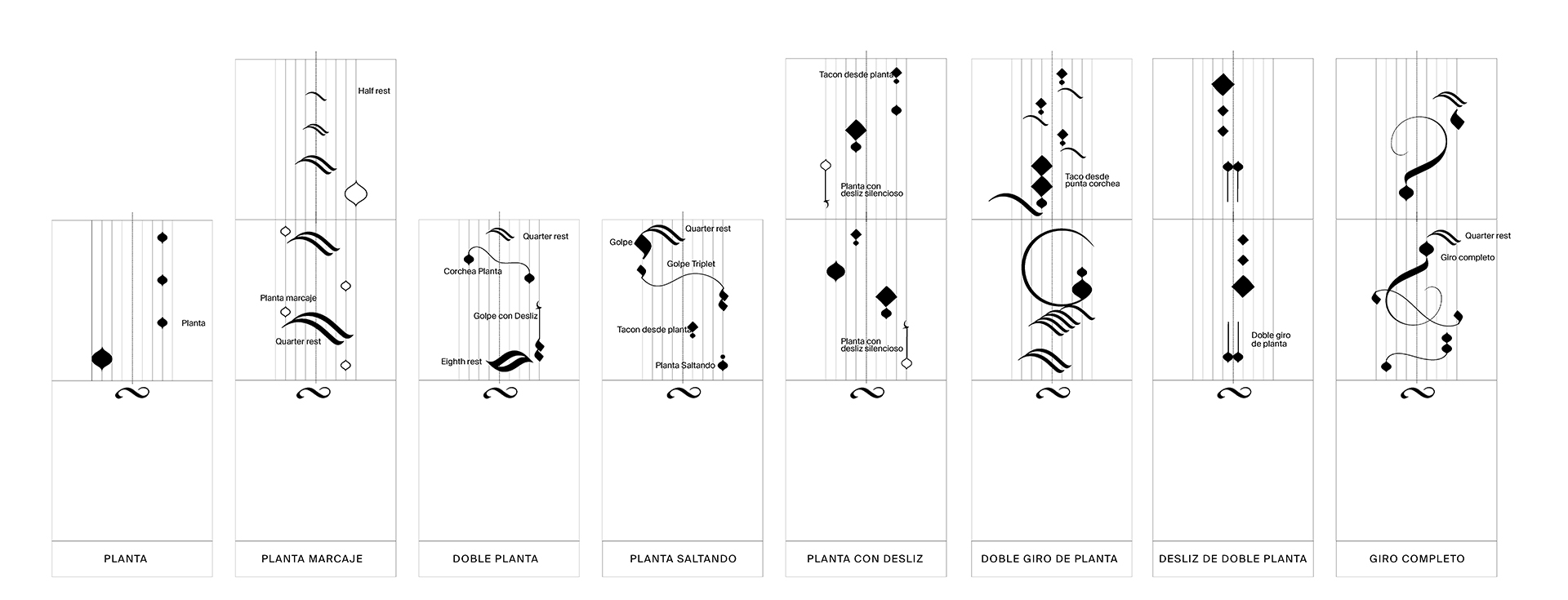
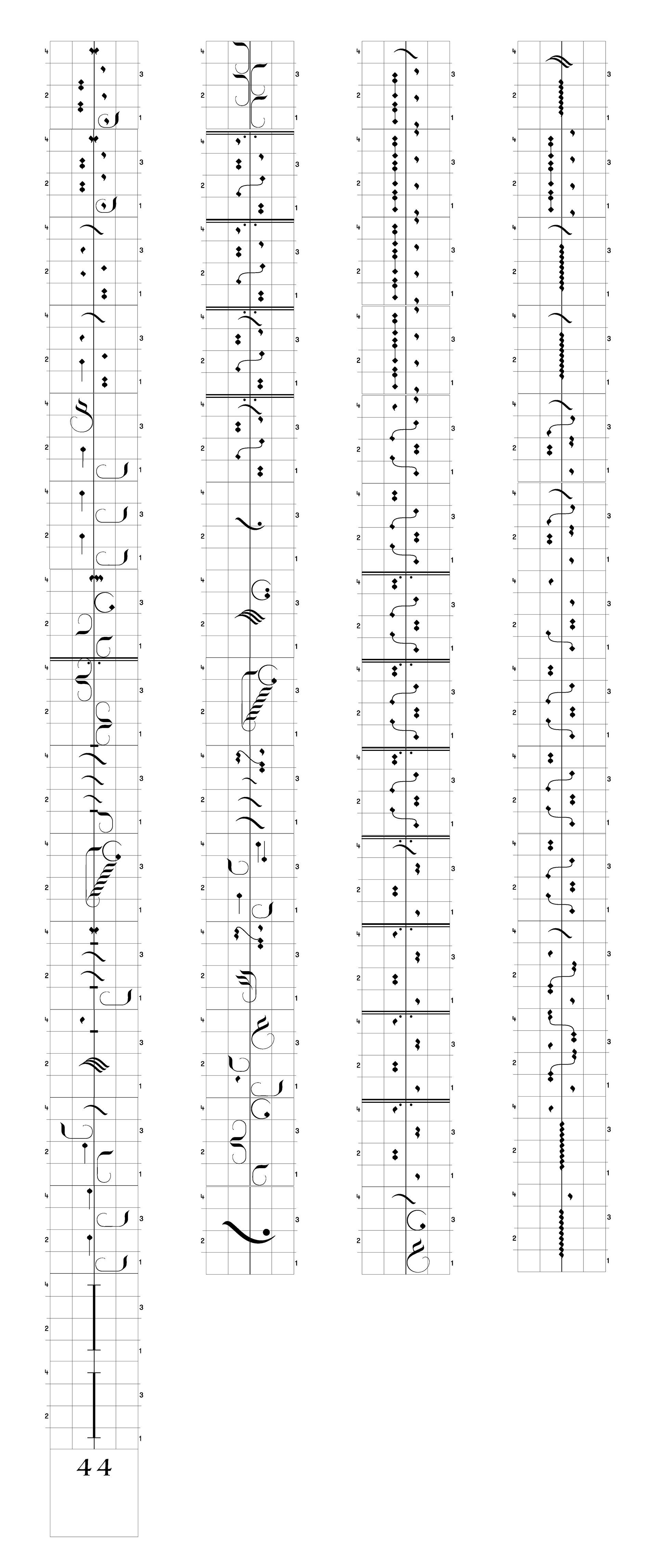
(Video)


VALUE OF THE NOTES
I made symbols for the value of the notes for some of the steps following traditional music notation with a different symbol.
—As Quavers (group of two notes, value 1/8, play for 1/2 beat)
—Triplets (group of 3 notes value 1/8, play for 1/2 beat)
—Semiquavers (group of 4 notes, 1/16, play for 1/4 beat)
—Whole rest (4 beat)
—Half rest (2 beats)
—Quarter rest (1 beat)
—Eight Rest (1/2 of a beat)
—Sixteenth Rest (1/4 of a beat)
a. Metric (Compass)
The square base, equivalent the rhythmic pattern or compass metric value on which the flamenco Palos (style or type of dances) are made, which helps to differentiate them.
Depending on the style, the compass is ternary (three times) or binary (two times), although the most characteristic of flamenco is the amalgam, the flamenco compass that combines the binary and the ternary. The compass is a key element in flamenco and one of the most distinctive characteristics of this genre, and because is the most important part of flamenco.
The compass indication is placed the beginning of the score with a fraction of numbers in which the numerator (left number) indicates said grouping and the denominator (right number) the figure that equals the time / pulse.
The rest of the steps are a mixed between the first 16 most important steps 8 plus several movements with legs, jumps and also turns. It has 48 symbols.
All the steps I made are convencional steps in flamenco.
There are a lot more, but the ones I made are the principles.
VALOR DE LAS NOTAS
Hice símbolos para el valor de las notas para algunos de los pasos siguiendo la notación musical tradicional con un símbolo diferente.
—Como corcheas (grupo de dos notas, valor 1/8, tocar durante 1/2 tiempo)
—Triplets (grupo de 3 notas valor 1/8, tocar por 1/2 tiempo)
—Semiquavers (grupo de 4 notas, 1/16, tocar 1/4 de tiempo)
—Descanso completo (4 tiempos)
—Medio descanso (2 latidos)
—Trimestre de descanso (1 latido)
—Ocho descanso (1/2 de un latido)
—Décimo sexto descanso (1/4 de tiempo)
a. Metrica (Compás)
La base cuadrada, equivalente al patrón rítmico o valor métrico del compás sobre el que se elaboran los palos flamencos (estilo o tipo de bailes), que ayuda a diferenciarlos.
Dependiendo del estilo, el compás es ternario (tres tiempos) o binario (dos tiempos), aunque lo más característico del flamenco es la amalgama, el compás flamenco que combina lo binario y lo ternario. La brújula es un elemento clave en el flamenco y una de las características más distintivas de este género, y porque es la parte más importante del flamenco.
La indicación de la brújula se coloca al comienzo de la partitura con una fracción de números en la que el numerador (número de la izquierda) indica dicha agrupación y el denominador (número de la derecha) la cifra que equivale al tiempo / pulso.
El resto de pasos son una mezcla entre los primeros 16 pasos más importantes 8 más varios movimientos con piernas, saltos y también giros. Tiene 48 símbolos.
Todos los pasos que hice son pasos convencionales del flamenco.
Hay muchos más, pero los que hice son los principios.
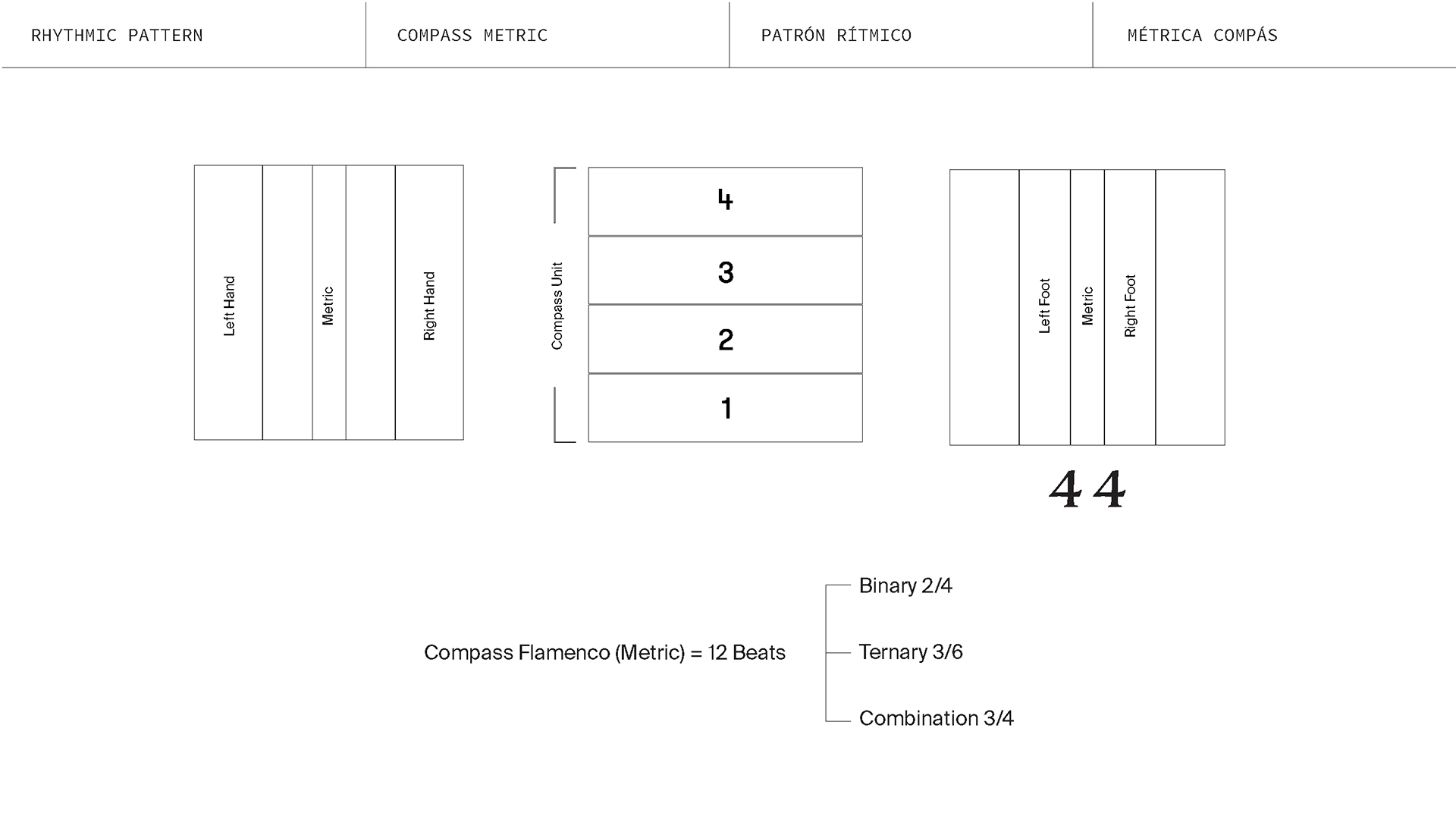
Layers Representation
Representación de las Capas



